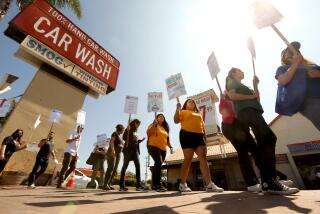Commentary : PERSPECTIVE ON LABOR : Meet the Frayed-Collar Workers Getting the Boot : The corporate obsession with spiking profits by cutting payrolls is doing long-term damage to the nation’s prosperity.
- Share via
On Labor Day, 1995, how we view the American economy depends on where we sit.
From one vantage point, the economy looks wildly successful. The World Economic Forum, which monitors the advanced industrial nations, now ranks the U.S. economy the most competitive in the world. In the 30 months of the Clinton presidency, we have seen the creation of more than 7 million new jobs.
But viewed from other seats, the American economy looks more wild than successful. Most blue-collar workers and mid-level white-collar managers say they are overworked and overwhelmed. Call them frayed-collar workers.
Consider what’s happened since last Labor Day:
* Figures released last week show that corporate profits in the past year increased 5.2%.
* Median wages have fallen from $479 a week last year to $475 a week (factoring in inflation) this year. It was $498 in 1979. Health benefits have declined as well.
* Americans are working harder. More people are moonlighting. In May, 1995, nearly 8 million people were holding two or more jobs--636,000 more people than one year earlier. That’s the highest portion of Americans holding two jobs since data were first collected 25 years ago.
These three facts are intertwined. A major reason profits have been climbing is that most peoples’ wages and benefits haven’t. And because median wages are down, most families have had to work longer and harder just to stay in place.
Profits are up; paychecks are not. How to explain this apparent paradox of frayed-collar workers in gold-plated times? Too many firms are taking the low road to competitive advantage. Instead of investing in their workers’ skills, their chief strategy for increasing profits has been to slash payrolls. Since profit is simply total revenues minus total expenses, many employers find cost-cutting the safer, surer route to short-term improvements in the bottom line. And since wages and benefits total almost 70% of a typical business’s expenses, the management theory in fashion today seeks higher output per worker (and thus higher profits) through cutting spending on workers.
Some companies do it by shrinking the core business and subcontracting to firms (here or abroad) that pay lower wages and offer fewer benefits.
Others replace workers with computerized information systems--on the theory that software can do it all more cheaply.
These techniques have indeed lifted productivity. But they haven’t translated into higher wages for frayed-collar workers, because the value that these workers themselves add has not increased. Individuals who remain in the company aren’t “worth” more even though their output may be greater, since they have no greater skill than they did before. Individuals lack the leverage to get a raise, because so many others stand ready to take their place at the old rate, and labor unions are often too weak to help. Meanwhile, the workers who have been outsourced, downsized, subcontracted, temped or replaced by technology aren’t “worth” more either. They simply bounce to another job at a lower wage.
In the process, about the only people who have the opportunity to add real value are the ones who make the key decisions about how to pare payrolls. Top CEOs are flying high on these sorts of productivity gains. They also own a lot of shares of stock whose value is likewise soaring.
Thus has the income gap continued to widen between top earners and everyone else. Almost all growth in family incomes during the past 15 years has gone to the top 20%, while the typical American family is living on less than it did 15 years ago, accounting for inflation.
Let me offer a Labor Day warning: This is not the path to prosperity.
If middle-class wages erode and families have less to spend, who will buy the goods and services our companies churn out? And who will come up with the cost-saving innovations, the new marketing ideas, the cutting-edge designs if workers are treated as disposable parts, their loyalty never rewarded?
In order for more Americans to benefit from productivity growth, this growth must be rooted in their added knowledge and insight. Rather than viewing workers as costs to be cut, companies must regard their workers as assets whose value can be enhanced through learning and experience.
Instead of this obsession with cutting payrolls, more attention should be directed to turning routine production workers into innovators.
How can top executives and shareholders be persuaded to follow this high road to productivity? Perhaps we need laws and rules that encourage these practices. Congress or the SEC might consider, for example, giving longer-term investors, who are likely to be more concerned about such things, greater votes in proxy contests than short-term speculators, who are likely to be more interested in a quick spike in stock price. Or maybe we should ask whether new tax breaks to spark investments in worker skills might be more worthy than additional tax breaks to encourage spending on new machines. There should be incentives for profit-sharing. While we’re at it, perhaps we also need disincentives aimed at profitable companies that lay off their workers.
Finally, let’s not forget the basic way to give ordinary workers more bargaining power: A revived labor union movement, focused on helping firms gain higher productivity while at the same time directing some of the gains to ordinary workers, is more essential than ever.
What better time to start giving American workers a piece of the action than now, when the economy is strong and profits are surging? That would make this Labor Day an occasion for all to celebrate.
More to Read
Get the L.A. Times Politics newsletter
Deeply reported insights into legislation, politics and policy from Sacramento, Washington and beyond. In your inbox twice per week.
You may occasionally receive promotional content from the Los Angeles Times.








